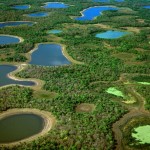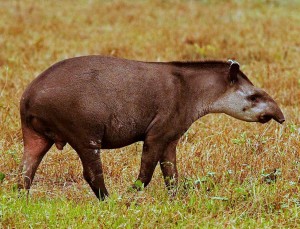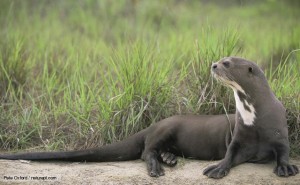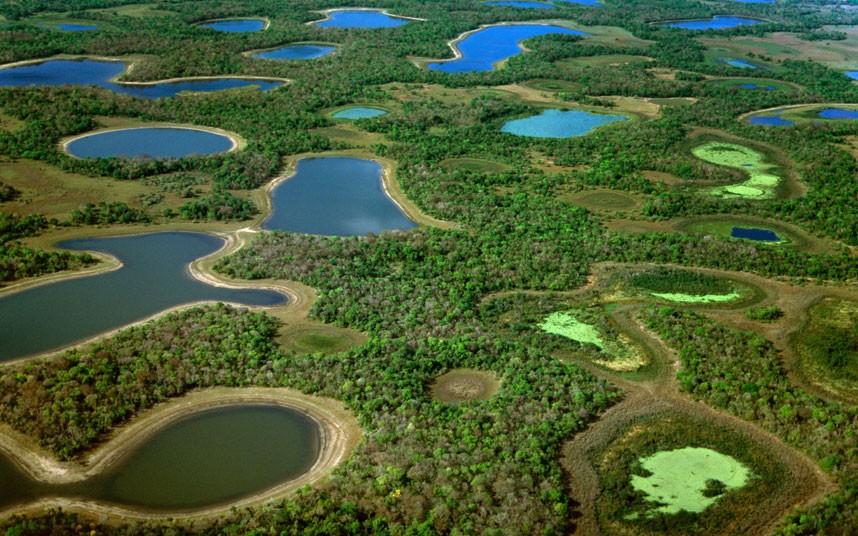 Listed as an UNESCO World Heritage Area and one of the world’s largest tropical wetlands, the Pantanal covers 188,000 ha in western central Brazil. Bordering Bolivia and Paraguay, this freshwater ecosystem, fed by the Cuiabá and Paraguay rivers, is home to a variety of species found nowhere else on Earth. Modern pressures and an ever-growing human population continue to pose challenges for wildlife conservation and habitat preservation. Research projects centered on such species as the lowland tapir, giant river otter, and jaguar work relentlessly to mitigate human-wildlife conflict and secure safe rangeland to ensure wildlife are protected and given the opportunity to thrive as they once did.
Listed as an UNESCO World Heritage Area and one of the world’s largest tropical wetlands, the Pantanal covers 188,000 ha in western central Brazil. Bordering Bolivia and Paraguay, this freshwater ecosystem, fed by the Cuiabá and Paraguay rivers, is home to a variety of species found nowhere else on Earth. Modern pressures and an ever-growing human population continue to pose challenges for wildlife conservation and habitat preservation. Research projects centered on such species as the lowland tapir, giant river otter, and jaguar work relentlessly to mitigate human-wildlife conflict and secure safe rangeland to ensure wildlife are protected and given the opportunity to thrive as they once did.
Since the late 1970’s, Panthera’s Drs. George Schaller and Howard Quigley have been working on an ongoing comprehensive ecological field study on jaguar in the Pantanal. One of the biggest threats to jaguars is conflict with beef farmers around the Pantanal region. Farmers clearing land to plant crops or make room for cattle grazing has not only compromised jaguar habitat but also prey availability. Using data collected from an almost 40 year study, jaguar conservationists have been able to gather insight on the lives of these magnificent creatures, i.e., where and when they travel and hunt, reproduction, genetics, etc. Conservation efforts by Panthera working with national and local governments, as well as nongovernmental conservation groups have facilitated educational outreach programs helping locals understand why it is important to learn to live in peaceful coexistence with the jaguar and farmers better livestock husbandry practices to decrease the chance of a conflict with a jaguar and minimize environmental impact. In addition, the establishment of the Jaguar Corridor Initiative will help reconnect jaguars via a genetic corridor from Mexico to Argentina.
comprehensive ecological field study on jaguar in the Pantanal. One of the biggest threats to jaguars is conflict with beef farmers around the Pantanal region. Farmers clearing land to plant crops or make room for cattle grazing has not only compromised jaguar habitat but also prey availability. Using data collected from an almost 40 year study, jaguar conservationists have been able to gather insight on the lives of these magnificent creatures, i.e., where and when they travel and hunt, reproduction, genetics, etc. Conservation efforts by Panthera working with national and local governments, as well as nongovernmental conservation groups have facilitated educational outreach programs helping locals understand why it is important to learn to live in peaceful coexistence with the jaguar and farmers better livestock husbandry practices to decrease the chance of a conflict with a jaguar and minimize environmental impact. In addition, the establishment of the Jaguar Corridor Initiative will help reconnect jaguars via a genetic corridor from Mexico to Argentina.
 Although not as well known as the jaguar, the lowland tapir plays a significant role in maintaining the ecosystem of the Pantanal. Looking a bit like a cross between a pig and a horse with a very flexible proboscis, tapirs are critical for seed dispersal, prey items for large predators like the jaguar, and shaping the landscape as they move through the area. One of four existing species found on two separate continents, the lowland tapir is considered a vulnerable species by the IUCN. Conflicts with humans via habitat destruction and hunting are currently the biggest threats to this unique megafauna. Using radiotelemetry and camera traps, conservationists with the Lowland Tapir Conservation Initiative lead by Dr. Patricia Medici are gaining a better understanding on the social complexities, reproductive physiology, and distribution pattern of the lowland tapir. These data will allow for conservation plans to be written to guarantee species survival. Considered a keystone species, the tapir is considered fundamental for overall biome longevity.
Although not as well known as the jaguar, the lowland tapir plays a significant role in maintaining the ecosystem of the Pantanal. Looking a bit like a cross between a pig and a horse with a very flexible proboscis, tapirs are critical for seed dispersal, prey items for large predators like the jaguar, and shaping the landscape as they move through the area. One of four existing species found on two separate continents, the lowland tapir is considered a vulnerable species by the IUCN. Conflicts with humans via habitat destruction and hunting are currently the biggest threats to this unique megafauna. Using radiotelemetry and camera traps, conservationists with the Lowland Tapir Conservation Initiative lead by Dr. Patricia Medici are gaining a better understanding on the social complexities, reproductive physiology, and distribution pattern of the lowland tapir. These data will allow for conservation plans to be written to guarantee species survival. Considered a keystone species, the tapir is considered fundamental for overall biome longevity.
Giant river otters remain endangered throughout their fragmented range. Otter populations were decimated in the 1950s and 1960s due to hunting for their pelts. It was once thought total otter numbers were as low as under 100 individuals. Conservation efforts have yielded in a significant increase in giant river otters over the last 30 years; however, habitat degradation, conflict with fishermen, and depleting food sources remain an ever-present threat. Conservation projects focusing on reproduction, environmental requirements (den sites), and diet have helped otter biologists develop long-term management initiatives.
the 1950s and 1960s due to hunting for their pelts. It was once thought total otter numbers were as low as under 100 individuals. Conservation efforts have yielded in a significant increase in giant river otters over the last 30 years; however, habitat degradation, conflict with fishermen, and depleting food sources remain an ever-present threat. Conservation projects focusing on reproduction, environmental requirements (den sites), and diet have helped otter biologists develop long-term management initiatives.
The Pantanal is home to over 80 mammalian, 650 bird, 50 reptilian, and 400 fish species, some of which are unique to this area. Through persistence and passion, conservation groups are gaining ground to secure precious habitat and help in the overall survival of some amazing creatures. As it is seen all around the world, human-wildlife conflict appears to be the underlying cause of habitat degradation and loss of populations. Gathering data to better understand how wildlife utilizes, contributes, and travel through their habitat gives conservationists a foundation on which to build long-lasting conservations plans. What we learn today can be applied to not only help future generations of wildlife but also humans within the breathtaking Pantanal.
For more information on the Lowland Tapir Conservation Initiative and Dr. Patricia Medici please check out the following links:
http://news.mongabay.com/2011/0911-hance_medici_interview.html?homepg
You can find more information about Panthera’s work with the jaguar at the following link:
